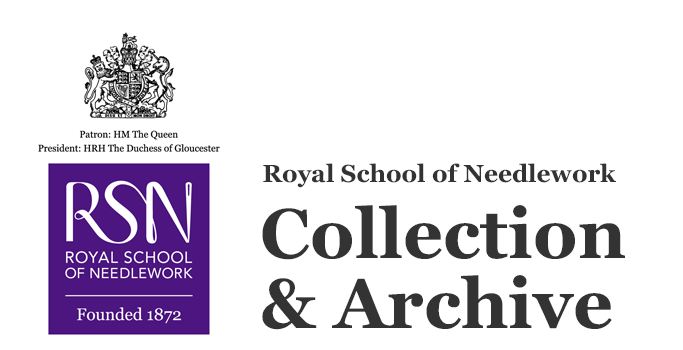Pocket book
Object name
Date made
1780s
Place made
Description
Circa 1780s tambour work pocket book with original key and an overall design of quivers, arrows, and flower garlands.
Content description
Circa 1780s pocket book made of cream-coloured silk and adorned with tambour work silk thread embroidery in soft, pastel colours. Each of the four sides of the pocket book has the same design, with a pink embroidered quiver of arrows in front of a brown bow and arrow and a looping leaf design. The 'feathers' of each arrow are made of straight stitches. Above the quivers are two draping vines from which leaves and pink flowers grow. Along the edges are borders with straight lines of yellow thread and two additional wavy, intersecting lines in pink and burgundy thread. Scattered around the central quiver are various sprigs of blue and pink flowers. From the bottom corners grow trios of yellow and burgundy reed-like flowers. The spine of the pocket book features a wavy line in yellow thread, embellished with small blue dots in each open space. The pocket book is edged with a pale blue braid.
Both of the inside sides of the pocket book have openings at the top to hold goods. One of the inside sides features the original lock plate. The top of the lock is attached to a scalloped flap, which is decorated with a border of blue and yellow lines and a line of intersecting wavy pink and burgundy threads at the top. The middle of the flap has pink and blue sprigs of flowers. The bottom of the lock covers the quiver design. The pocket book's original key is attached to the pocket book with a length of silk ribbon, a replacement for the original blue silk ribbon.
Pocket books were carried by both men and women in the 18th and early 19th centuries, tucked away in a man’s coat pocket or the pockets women wore under their skirts. These pocket books held precious objects such as paper money, letters, important documents, and sewing supplies. In the United States the vast majority of pocket books were adorned in flame stitch designs worked in wool threads, whereas in Europe designs tended to be more floral and worked in silk threads. It is believed that six pocket books from this period were given to the RSN by Mary of Teck, Queen of the United Kingdom and the British Dominions, and Empress of India. This is one of that group.
Both of the inside sides of the pocket book have openings at the top to hold goods. One of the inside sides features the original lock plate. The top of the lock is attached to a scalloped flap, which is decorated with a border of blue and yellow lines and a line of intersecting wavy pink and burgundy threads at the top. The middle of the flap has pink and blue sprigs of flowers. The bottom of the lock covers the quiver design. The pocket book's original key is attached to the pocket book with a length of silk ribbon, a replacement for the original blue silk ribbon.
Pocket books were carried by both men and women in the 18th and early 19th centuries, tucked away in a man’s coat pocket or the pockets women wore under their skirts. These pocket books held precious objects such as paper money, letters, important documents, and sewing supplies. In the United States the vast majority of pocket books were adorned in flame stitch designs worked in wool threads, whereas in Europe designs tended to be more floral and worked in silk threads. It is believed that six pocket books from this period were given to the RSN by Mary of Teck, Queen of the United Kingdom and the British Dominions, and Empress of India. This is one of that group.
Dimensions
width: 15cm
length: 22cm
length: 22cm
Materials
Stitches
Techniques
Motifs
Credit line
Possible gift of Her Majesty Queen Mary.
Catalogue number
RSN.32.b
© Royal School of Needlework

